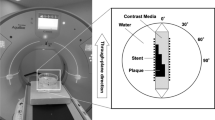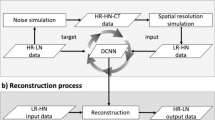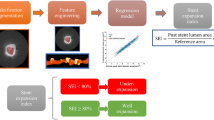Abstract
Objectives
Evaluation of in-stent restenosis (ISR), especially for small stents, remains challenging during computed tomography (CT) angiography. We used deep learning reconstruction to quantify stent strut thickness and lumen vessel diameter at the stent and compared it with values obtained using conventional reconstruction strategies.
Methods
We examined 166 stents in 85 consecutive patients who underwent CT and invasive coronary angiography (ICA) within 3 months of each other from 2019–2021 after percutaneous coronary intervention with coronary stent placement. The presence of ISR was defined as percent diameter stenosis ≥ 50% on ICA. We compared a super-resolution deep learning reconstruction, Precise IQ Engine (PIQE), and a model-based iterative reconstruction, Forward projected model-based Iterative Reconstruction SoluTion (FIRST). All images were reconstructed using PIQE and FIRST and assessed by two blinded cardiovascular radiographers.
Results
PIQE had a larger full width at half maximum of the lumen and smaller strut than FIRST. The image quality score in PIQE was higher than that in FIRST (4.2 ± 1.1 versus 2.7 ± 1.2, p < 0.05). In addition, the specificity and accuracy of ISR detection were better in PIQE than in FIRST (p < 0.05 for both), with particularly pronounced differences for stent diameters < 3.0 mm.
Conclusion
PIQE provides superior image quality and diagnostic accuracy for ISR, even with stents measuring < 3.0 mm in diameter.
Clinical relevance statement
With improvements in the diagnostic accuracy of in-stent stenosis, CT angiography could become a gatekeeper for ICA in post-stenting cases, obviating ICA in many patients after recent stenting with infrequent ISR and allowing non-invasive ISR detection in the late phase.
Key Points
• Despite CT technology advancements, evaluating in-stent stenosis severity, especially in small-diameter stents, remains challenging.
• Compared with conventional methods, the Precise IQ Engine uses deep learning to improve spatial resolution.
• Improved diagnostic accuracy of CT angiography helps avoid invasive coronary angiography after coronary artery stenting.
Graphical Abstract




Similar content being viewed by others
Abbreviations
- AiCE:
-
Advanced intelligent clear-IQ engine
- FFRCT :
-
Computed tomography angiography–derived fractional flow reserve
- CTA:
-
Coronary computed tomography angiography
- FIRST:
-
Forward projected model-based Iterative Reconstruction SoluTion
- FWHM-Lumen:
-
Full width at half maximum of lumen
- FWHM-Stent:
-
Full width at half maximum of strut
- ISR:
-
In-stent-restenosis
- ICA:
-
Invasive coronary angiography
- LCX:
-
Left circumflex
- LMT-LAD:
-
Left main trunk-left ascending artery
- %DS:
-
Percent diameter stenosis
- PCI:
-
Percutaneous coronary intervention
- PIQE:
-
Precise IQ Engine
- RCA:
-
Right coronary artery
- SR-DLR:
-
Super-resolution deep learning reconstruction
- URCT:
-
Ultra-high-resolution CT
References
Knuuti J, Wijns W, Saraste A et al (2020) 2019 ESC Guidelines for the diagnosis and management of chronic coronary syndromes. Eur Heart J 41:407–477
Min JK, Leipsic J, Pencina MJ et al (2012) Diagnostic accuracy of fractional flow reserve from anatomic CT angiography. JAMA 308:1237–1245
Min JK, Taylor CA, Achenbach S et al (2015) Noninvasive fractional flow reserve derived from coronary CT angiography: clinical data and scientific principles. JACC Cardiovasc Imaging 8:1209–1222
Pontone G, Rossi A, Guglielmo M et al (2022) Clinical applications of cardiac computed tomography: a consensus paper of the European Association of Cardiovascular Imaging-part I. Eur Heart J Cardiovasc Imaging 23:299–314
Motoyama S, Ito H, Sarai M et al (2018) Ultra-high-resolution computed tomography angiography for assessment of coronary artery stenosis. Circ J 82:1844–1851
Schuijf JD, Lima JAC, Boedeker KL et al (2022) CT imaging with ultra-high-resolution: opportunities for cardiovascular imaging in clinical practice. J Cardiovasc Comput Tomogr 16:388–396
Nishii T, Funama Y, Kato S et al (2022) Comparison of visibility of in-stent restenosis between conventional- and ultra-high spatial resolution computed tomography: coronary arterial phantom study. Jpn J Radiol 40:279–288
Lee TC, Zhou J, Yu Z, et al (2022) Deep learning enabled wide-coverage high-resolution cardiac CT. In: Medical Imaging 2022: Physics of Medical Imaging vol. 12031, pp. 675–678. SPIE. https://www.spiedigitallibrary.org/conference-proceedings-of-spie/12031/120312O/Deep-learning-enabled-wide-coverage-high-resolution-cardiac-CT/10.1117/12.2611817.short?SSO=1
Boedeker K (2021) Precision-trained deep learning: Redefining cardiac imaging. Available via https://canonmedical.widen.net/content/xyva2vxmfy/original/MWPCT0008EA_fin.pdf?u=vmbupa&
Tatsugami F, Higaki T, Nakamura Y et al (2019) Deep learning-based image restoration algorithm for coronary CT angiography. Eur Radiol 29:5322–5329
Tatsugami F, Higaki T, Sakane H et al (2017) Coronary artery stent evaluation with model-based iterative reconstruction at coronary CT angiography. Acad Radiol 24:975–981
Andreini D, Pontone G, Mushtaq S et al (2019) Diagnostic accuracy of coronary CT angiography performed in 100 consecutive patients with coronary stents using a whole-organ high-definition CT scanner. Int J Cardiol 274:382–387
Yang J, Yang X, De Cecco CN et al (2017) Iterative reconstruction improves detection of in-stent restenosis by high-pitch dual-source coronary CT angiography. Sci Rep 7:6956
Tatsugami F, Higaki T, Sakane H et al (2018) Diagnostic accuracy of in-stent restenosis using model-based iterative reconstruction at coronary CT angiography: initial experience. Br J Radiol 91:20170598
Geyer LL, Glenn GR, De Cecco CN et al (2015) CT evaluation of small-diameter coronary artery stents: effect of an integrated circuit detector with iterative reconstruction. Radiology 276:706–714
Eisentopf J, Achenbach S, Ulzheimer S et al (2013) Low-dose dual-source CT angiography with iterative reconstruction for coronary artery stent evaluation. JACC Cardiovasc Imaging 6:458–465
Narula J, Chandrashekhar Y, Ahmadi A et al (2021) SCCT 2021 Expert consensus document on coronary computed tomographic angiography: a report of the Society of Cardiovascular Computed Tomography. J Cardiovasc Comput Tomogr 15:192–217
Dai T, Wang JR, Hu PF (2018) Diagnostic performance of computed tomography angiography in the detection of coronary artery in-stent restenosis: evidence from an updated meta-analysis. Eur Radiol 28:1373–1382
Funding
The authors state that this work has not received any funding.
Author information
Authors and Affiliations
Corresponding author
Ethics declarations
Guarantor
The Scientific guarantor is Hideki Kawai.
Conflict of interest
Yoshiharu Ohno and Hiroshi Toyama have received research grants from Canon Medical Systems. Hideo Izawa has received grant support through his institution from Bayer, Daiichi-Sankyo, Dainihon-Sumitomo, Kowa, Ono, Otsuka, Takeda, and Fuji Film Toyama Kagaku, and honoraria for lectures from Boehringer Ingelheim, Daiichi-Sankyo, Novartis, and Otsuka Corporation. The remaining authors have nothing to disclose.
Statistics and biometry
One of the authors (Hiroshi Takahashi) has significant statistical expertise.
Informed consent
Written informed consent was obtained from all subjects (patients) in this study.
An opt-out method on our department’s website was used to obtain consent for this study.
Ethical approval
Institutional Review Board approval was obtained.
The study protocol was approved by the Institutional Review Board and ethics committees of the Fujita Health University.
Study subjects or cohorts overlap
None.
Methodology
• Retrospective
• diagnostic study
• performed at one institution
Additional information
Publisher's note
Springer Nature remains neutral with regard to jurisdictional claims in published maps and institutional affiliations.
Rights and permissions
Springer Nature or its licensor (e.g. a society or other partner) holds exclusive rights to this article under a publishing agreement with the author(s) or other rightsholder(s); author self-archiving of the accepted manuscript version of this article is solely governed by the terms of such publishing agreement and applicable law.
About this article
Cite this article
Kawai, H., Motoyama, S., Sarai, M. et al. Coronary computed tomography angiographic detection of in-stent restenosis via deep learning reconstruction: a feasibility study. Eur Radiol 34, 2647–2657 (2024). https://doi.org/10.1007/s00330-023-10110-7
Received:
Revised:
Accepted:
Published:
Issue Date:
DOI: https://doi.org/10.1007/s00330-023-10110-7




